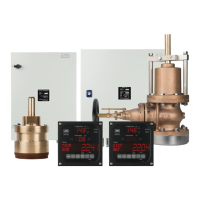6-47
Annex Wiring principles
Cable Dimensions and Standards
Make sure that the all cables are approved for marine environment usage.
Signal Cables
x All cables used for signal interconnection of the Speed-log system units shall have a
cross section of at least 0.5 mm
2
with a voltage rating of at least 60 volts and be
screened, either an aluminium foil screen with an inlaid, blank, stranded conductor, or
tinned copper braid should be used.
x If the specifications state “twisted pair”, such cable should be used.
It is recommended to use a cable with numbered conductors. This makes identification much
easier, and minimizes the risk of miss-connections.
DC Power Cables
x All cables specified to be DC power cables in the Speed-log system shall have a cross
section of at least 1.5 mm
2
with a voltage rating of at least 120 volts. Using any other
cable type will void warranty.
x The installation directions may specify a heavier cross section.
It is recommended to increase the cross section at longer runs of cable (e.g. exceeding 10 meter)
to avoid problems with voltage drops.
It is also recommended to use cable with coloured conductors, preferable one red part for the
positive voltage and one black part for negative return.
AC Power Cable
x All cables used for supplying AC power in the Speed-log system shall have a cross
section of at least 1.5 mm
2
with a voltage rating of at least 500 volts.
x The cable must be UL registered, for the environment in which it is used. Failing to use
UL registered cable will void warranty.
x The cable must have three conductors, coloured blue, brown and yellow-green. The
yellow-green part is to be used for grounding only.
Follow established electrical safety regulations when selecting and using high voltage cabling.
Comments to signal cabling
Noise
All cables with two or more parts are twisted (stranded) for manufacturing reasons. This does
not mean any two-conductor cable is a “Twisted Pair”.
• “Twisted pair” means two separated and isolated wires, twisted together in a special
noise-cancelling configuration.
• “Two twisted pairs” means two separate sets of such two wires, twisted together, not
four wires twisted together.
The twisted pair is a unit that by its twist protects itself from the environment, and protects the
environment (such as, the pair next to it) from itself. The pitch of the twist is carefully
calculated to maximize the noise-cancelling properties, which is not the case with ordinary
multi-pole cable. Thus, when using “Two twisted pairs” make sure using the two wires twisted
together and not one wire from each twisted pair.

